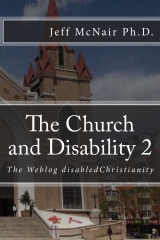The authors surveyed a national random sample of 5,837 middle school students on
their attitudes toward the inclusion of peers with intellectual disabilities
(ID). The national sample provided results that were accurate, with a margin of
error of +/- 1.4%. Findings indicated that youth (a) have limited contact with
students with ID in their classrooms and school; (b) perceive students with ID
as moderately impaired rather than mildly impaired; (c) believe that students
with ID can participate in nonacademic classes, but not in academic classes; (d)
view inclusion as having both positive and negative effects; and (e) do not want
to interact socially with a peer with ID, particularly outside school.
Structured equation modeling showed that youth's perceptions of the competence
of students with ID significantly influence their willingness to interact with
these students and their support of inclusion.
Tuesday, July 10, 2007
Community integration through the public schools
The following is the abstract from a study published in Exceptional Children, a journal of the Council on Exceptional Children, entitled "A National Study of Youth Attitudes Toward the Inclusion of Students with Intellectual Disabilities" by Siperstein, Parker, Bardon and Widaman (2007, Vol. 73, No. 4, 435-455).
Those of us in special education, know that inclusion has been the perspective of many in education for the past 15-20 years. You must understand that there are many perspectives on inclusion in the public schools. There are those who are total zealots who feel that the only place for any child, independent of their disability is the "regular classroom with their age peers." There are others who feel that children with disabilities should be segregated into separate schools where they can receive "intensive therapy." Others hold differing positions somewhere in the middle, although the politically correct position is much more toward the inclusion in the regular class over the segregation position. There have been many studies, largely anecdotal that speak of the trememdous benefits to children with and without disabilities as a result of inclusion. There have not been many empirical studies supporting the inclusion position in terms of long term integration benefits.
Now one cannot take a position on the basis of one study, but I must admit that I find this study quite sad. You see, at least in regard to the children who participated in this study and the larger group they may represent, inclusion is not working very well.
We see that in the summary results,
limited contact in classrooms and school,
students perceived as more impaired than they are,
inclusion has both positive and negative effects, and
typical children do not want to interact socially with a peer with ID, particularly outside school.
The question remains in my mind as to whether or not the school, in particular the general education classroom, is the best place for integration. The assumption from some researchers and inclusion zealots is that it is the best place. The authors of the article conclude that their research might demonstrate that, "inclusion is not working; that the policies and practices put in place have not reduced or eliminated the social barriers to inclusion for students with ID; and thus, that the social goals of including students with ID in general education enviornments may not be attainable or even realistic" or contrarily perhaps "we have not yet done enough to promote inclusion and that we cannot rely on physical inclusion by itself to foster positive attitudes." What the authors do conclude is, "What the results of this survey do indicate is that finding ways for youth to witness the competence of people with ID would go a long way toward fostering positive attitudes." How many opportunities are provided in schools for children with intellectual disabilities, with mental retardation to demonstrate competence when the point of integration is the cognitively oriented, regular class curricula? We set them up for failure in many ways and then are surprised when they are seen as less than competent.
The saddest of the findings, however, was that typical children do not want to interact socially with a peer with ID, particularly outside school. That is probably one of the reasons why thsy see their peers as more disabled than they actually are...they don't know them. The study implies that peer pressure would cause the lack of interaction outside of school, which I don't quite get. I could see peer pressure in school, but outside of school there would be more opportunity for privacy in ones social interactions. But what type of setting would allow a person with an intellectual disablity to be seen as competent outside of school for the purposes of social integration. Many settings might be imagined, however, as this is "disabled Christianity" you know my obvious suggestion is the church. Schools cannot find the key to helping persons with disability to demonstrate competence so that positive attitudes might be developed. The Christian church has the potential to provide myriad opportunities for people with various diabilities to be seen in a competent, positive light, which the authors of the article contend would lead to community integration.
Schools have set the tone for integration through special education programs and efforts at inclusion, but they are failing at long term community integration I would suspect. Once again, can you see that the schools are not the answer to the integration question? Once again the answer for integration falls squarely at the feet of the church.
McNair
Subscribe to:
Post Comments (Atom)











No comments:
Post a Comment